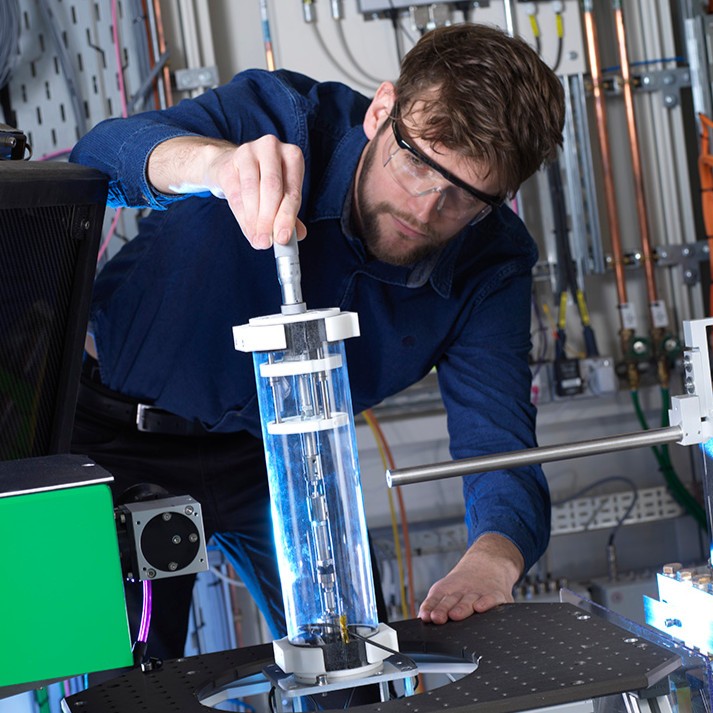James will champion battery research at the Rutherford Appleton Laboratory and help researchers in the battery community to realise the huge potential that neutrons and muons have in studying and developing battery materials. He is seeking input on how best to promote the facilities available at ISIS and the wider Rutherford Appleton Laboratory to the UK and international battery community, and how the infrastructure and facilities could be developed further. Please contact James Le Houx to discuss – he'd welcome your input james.le-houx@stfc.ac.uk.
 The development of high performance, sustainable battery materials is a collaborative research challenge that will play an enormous role in the global transition to electrification. Neutron and muon sources allow researchers to see in incredible detail, the structures within a battery, find out how they work on a fundamental level, and watch the dynamics as they progress in real time. The ISIS facility has already enabled important research into sodium-ion batteries, battery lifetime and performance, solid-state materials for next generation batteries and ion diffusion studies inside batteries. The new fellowship, based as ISIS, has been set up to strengthen and expand the networks of battery researchers across the globe using these techniques to deliver further solutions to remaining energy storage research challenges.
The development of high performance, sustainable battery materials is a collaborative research challenge that will play an enormous role in the global transition to electrification. Neutron and muon sources allow researchers to see in incredible detail, the structures within a battery, find out how they work on a fundamental level, and watch the dynamics as they progress in real time. The ISIS facility has already enabled important research into sodium-ion batteries, battery lifetime and performance, solid-state materials for next generation batteries and ion diffusion studies inside batteries. The new fellowship, based as ISIS, has been set up to strengthen and expand the networks of battery researchers across the globe using these techniques to deliver further solutions to remaining energy storage research challenges.
“This fantastic joint appointment will strengthen the links between ISIS and the Faraday Institution, develop battery science across the Harwell Campus and increase engagement with our industrial, academic and government partners," said Martin Owen-Jones, Energy Materials Coordinator at STFC. “We look forward to working with James to champion battery research at the Rutherford Laboratory and across the UK."
“Accelerating battery research requires not only access to the UK's world-class facilities such as those at ISIS Neutron and Muon Source but also leaders who can convene scientists and determine research directions," said Professor Pam Thomas, CEO, Faraday Institution. “We're delighted to welcome Dr James Le Houx as the inaugural Faraday ISIS Emerging Leader Battery Fellow who will serve as an important touchpoint for our research community. He will provide leadership in expanding ISIS's user base and knowledge of what the UK's central facilities have to offer as our research programmes deliver the underpinning scientific breakthroughs needed to electrify multiple sectors of the economy."
“At Harwell, we have the unique opportunity to take a lead in tackling some of the most pressing challenges in battery science, including improving performance, safety, and sustainability, said James Le Houx. “We have access to world-class facilities, such as ISIS, Diamond, the Central Laser Facilities that can provide us with cutting-edge tools and techniques to study batteries at different scales and modalities. We know the challenges, we have the facilities and we have the tools. Working with the Faraday Institution, my new role is to bring these teams together, sharing knowledge and building collaboration that will enable further world-changing battery research."
Until recently, Dr James Le Houx was a beamline scientist at the Diamond Light Source where he led battery characterisation research across the imaging and crystallography science groups. His position at the central facilities means he works widely across the Faraday Institution, working directly with eight of the flagship research projects. He is also a member of the Faraday Institution Early Career Researcher Committee and of the Scientific Programme Board for the Faraday Institution Annual Conference. His research focuses on using X-rays, neutrons and muons to study structures, mainly through both X-ray computed tomography, and X-ray powder diffraction techniques. He also leads the development of scattering tomography techniques (X-ray diffraction computed tomography, pair distribution function computed tomography) and uses the datasets from these characterisation techniques as computational domains for physics-based models, improving understanding of processes and performance.
The two organisations are jointly developing a series of Faraday Masterclasses focusing on utilising facilities at the Science and Technology Facilities Council (STFC) for battery research.
- Watch the recordings of Masterclasses presenting overviews of techniques:
- Follow the Faraday Institution on LinkedIn and X to receive notifications for upcoming events.
Read more about use of muon and neutron techniques to investigate and develop batteries.
